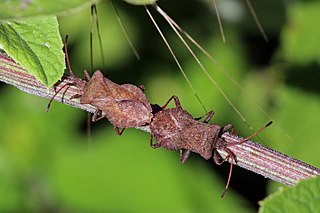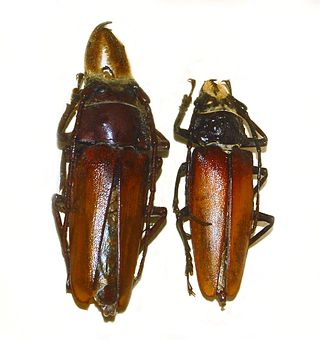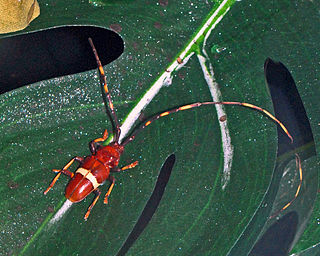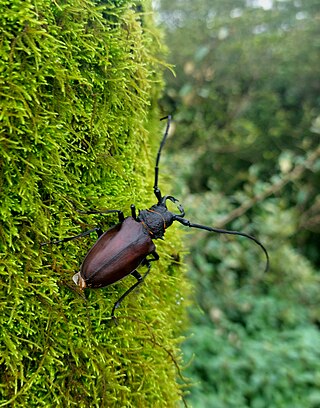Related Research Articles

The longhorn beetles (Cerambycidae), also known as long-horned or longicorns, are a large family of beetles, with over 35,000 species described. Most species are characterized by extremely long antennae, which are often as long as or longer than the beetle's body. In various members of the family, however, the antennae are quite short and such species can be difficult to distinguish from related beetle families such as the Chrysomelidae. The scientific name of this beetle family goes back to a figure from Greek mythology: after an argument with nymphs, the shepherd Cerambus was transformed into a large beetle with horns.

The Conopidae, also known as the thick-headed flies, are a family of flies within the Brachycera suborder of Diptera, and the sole member of the superfamily Conopoidea. Flies of the family Conopidae are distributed worldwide in all the biogeographic realms except for the poles and many of the Pacific islands. About 800 species in 47 genera are described worldwide, about 70 of which are found in North America. The majority of conopids are black and yellow, or black and white, and often strikingly resemble wasps, bees, or flies of the family Syrphidae, themselves notable bee mimics. A conopid is most frequently found at flowers, feeding on nectar with its proboscis, which is often long.

Platypezidae is a family of true flies of the superfamily Platypezoidea. The more than 250 species are found worldwide primarily in woodland habitats. A common name is flat-footed flies, but this is also used for the closely related Opetiidae which were formerly included in the Platypezidae.

Leucosidea sericea, commonly known as oldwood, is an evergreen tree or large shrub that grows in the highland regions of southern Africa. It is the sole species in the monotypic genus Leucosidea. The name oldwood may reflect the fact that the wood burns slowly, as if old and rotting; the gnarled, twisted trunks reinforce this impression.

Cerambyx cerdo, commonly known as the great capricorn beetle or cerambyx longicorn, is a species of beetle in family Cerambycidae. It occurs in North Africa, Europe, and Asia.
Monomorium denticulatum is a species of ant in the subfamily Myrmicinae. It known from Chile and Argentina. Like M. bidentatum it was first described from Valdivia, Chile.

Coreus marginatus is a herbivorous species of true bug in the family Coreidae. It is commonly known as the dock bug as it feeds on the leaves and seeds of docks and sorrels. It is a medium-sized speckled brown insect, between 13 and 15 mm long as an adult, with a broad abdomen. It occurs throughout Europe, Asia and northern Africa. It is often found in dense vegetation, such as hedgerows and wasteland.
Caloptilia glutinella is a moth of the family Gracillariidae. It is found in Canada and the United States. The species was first described by Charles Russell Ely in 1915.

Callipogon barbatum is a species of flat-faced longhorn beetle in the subfamily Prioninae of the family Cerambycidae.

Trachyderes succinctus is a species of beetle in the family Cerambycidae. It was described by Carl Linnaeus in his landmark 1758 10th edition of Systema Naturae.
Amphelictus aibussu is a species of beetle in the family Cerambycidae.

Abia sericea, common name club horned sawfly or scabious sawfly, is a species of sawflies belonging to the family Cimbicidae.

Diastocera is a monotypic genus in the family Cerambycidae described by Pierre François Marie Auguste Dejean in 1835. Its only species, the African Diastocera trifasciata, was described by Johan Christian Fabricius in 1775, but the Asian Thysia wallichii has on occasion been placed in the genus.
Parmenolamia unifasciata is a species of beetle in the family Cerambycidae, and the only species in the genus Parmenolamia. It was described by Stephan von Breuning in 1950, from a specimen collected in Quang Tre Vietnam.
Blera nigra , the Golden Haired Wood Fly, is a fairly common species of syrphid fly first officially described by Williston in 1887 Hoverflies get their name from the ability to remain nearly motionless while in flight The adults are also known as flower flies for they are commonly found around and on flowers from which they get both energy-giving nectar and protein rich pollen. The larvae are of the rat-tailed type feeding on exuding sap or in the rot holes of trees.

Oxynopterus mucronatus, sometimes known as the giant click beetle, is a species of click beetle from tropical Southeast Asia. Their larvae are specialized predators of termites.

Lepidiota is a genus of beetles belonging to the family Scarabaeidae.

Sphiximorpha willistoni, or Williston's wasp fly, is a rare species of syrphid fly found in eastern North America. It is a strong wasp mimic. Hoverflies can remain nearly motionless in flight. The adults are also known as flower flies for they are commonly found on flowers, from which they get both energy-giving nectar and protein-rich pollen. Larvae in this genus are found in sap runs of trees.

Priotyrannus mordax is a species of long-horned beetle in the subfamily Prioninae endemic to the forests of southern India.
Orthonevra robusta, the short-horned mucksucker, is a rare species of syrphid fly, located in the Western United States. It was described by Raymond Corbett Shannon in 1916. Hoverflies are able to be motionless while in flight.They are also called flower flies, for they are commonly found around and on flowers from which they get both energy-giving nectar and protein rich pollen. Larvae for this genus are of the rat-tailed type. O. robusta larvae have not been described.
References
- ↑ Bezark, Larry G. Catalogue Dorcasominae.pdf. Retrieved on 22 May 2012.
- ↑ "Occurrence Detail 1316106708". www.gbif.org. Retrieved 2023-12-14.
- 1 2 3 4 Vives, E. (December 14, 2023). "Notes on Lepturinae and Apatophysinae). New and interesting Apatophysinae from Southern Africa and notes on the genus Rhagiohabdium Adlbauer, 2001 (Coleoptera, Cerambycidae". ResearchGate.